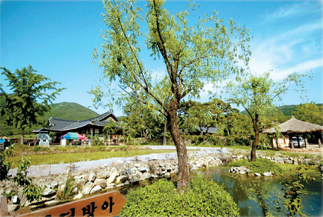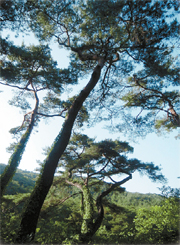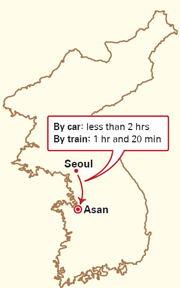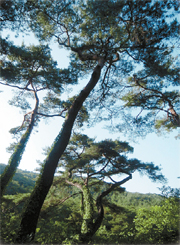A place where time stands still

The entrance to Oeam folk village, with a carriage attached to a fake cow. Photos by Lee Ho-jeong
Asan is known for its hot springs. But this town offers more than a nice, hot bath.
On the first step into this town one senses the soothing serenity of a Zen temple.

A small pond in the middle of the folk village.
Oeam village is a living museum, displaying touches of past rural life on the peninsula.
According to legend, people with the last names of Mok and Kang settled in the area 500 years ago.
Later, during King Seonjo’s reign of the Joseon Dynasty, the Lees of Yean, an academic and noble family, settled in the area, helping it gain nationwide recognition as a scholarly region.
The village has maintained its traditional appearance. It looks as if it just popped out of a history book. It has been used as a setting in several Korean films, including “The Brotherhood of War” and “Strokes of Fire.”
The village is separated from the other areas by a bridge. At the entrance to the village is a modern mill and several small taverns that sell traditional delights like mak-geolli, or rice wine, and pajeon, or Korean pizza, which visitors were enjoying outdoors. A bowl of makgeolli is the perfect refreshment for the early summer heat.

Pine trees on the trail to Bonggok Temple.
These totem poles used to be located in every village to ward off evil spirits and bad luck. Nowadays the totem poles are hard to see, other than in museums or in artistic exhibits.
The totem poles face a wide horizon of rice paddies, which is a sight for sore eyes for city dwellers used to the concrete jungle of Seoul. Behind the totem pole is a hill covered with towering pine trees and the open space of a grave.
West of the totem poles is a small water mill. Of course this water mill is just a replica; still, it’s delightful to look at and children can’t get enough of the splashing water that drops from the mill and then heads toward a small stream.


Pine trees on the trail to Bonggok Temple.
Because the west end of the village is low and the east is high, the buildings face either southwest or south.
Within the villages are several noble houses with tile roofs and large gardens within the walls. Some of the noble houses are called Champan, Camchal, Gyosu and Songhwa.
In the middle of a village is a mill where a huge wooden log bangs down on a stone bowl when one steps on it.
The village also has a deer farm located just east of the village. Visitors can get within close distance of the deer, but I advise you keep your distance. No matter how timid they look, these deer are huge and when they move quickly, it can be hard to get out of their way.
Although the village may not seem big, it takes roughly an hour to cover the area.
Not far from Oeam village is Bonggok Temple, which sits on the northeastern valley of Mount Bongsu.
The temple is known mostly for its pine forest trail. It takes roughly 30 minutes to walk up to the Buddhist temple.
The entrance of the trail really doesn’t stand out because there are no signs indicating that it is a famous trail. There’s just a small opening and parking lot at the end of a country road that passes through fields and farmhouses.
The pine trees in the woods are amazingly tall and almost cover the sky. Streams of light pass through the trees and branches.
Some of the trees are even interestingly nearly heart-shaped.
Even in early summer, the heat stings the skin, and the trail covered by the high towering pine woods provides a cool shade. When a light breeze passes, the fine scent from the pines transports visitors to a tranquil state of mind. Of course, being in the woods also means being swamped by small flies and other bugs.
When looking at the pines closely, however, one will notice that many of them have scars. The story has it that the scars were made during the Japanese colonial period when the Japanese carved the pines to collect sap. The scars are ugly and clearly visible. It looks as if the pines have been stripped naked.
At the end of the trail is the temple. The temple itself is modest and doesn’t have a stone statue of Buddha or a stone tower.
There are three buildings and a wide, open space. It seems to be what a temple should be - simple.
Sitting on the wooden floor of one of the buildings and looking at the pine forest, one’s mind drifts off into the distance. One feels enchanted by the peace of the surroundings, until a group of noisy tourists intrude.
Also within Asan is the famous Hyeon-chung Temple.
Hyeonchung is a shrine that commemorates General Yi Sun-shin of the Joseon Dynasty, who gave his life in the fight against the Japanese invasion. He is also known for his creation of the famed armored turtle battleship. The shrine is located next to the house where Yi was born and raised.
The steps to the shrine are long and exhausting. But once at the shrine the surrounding area emerges in a breathtaking single view.
One has to say that whoever decided to place the shrine at its current location made the right decision.
Within the shrine is a huge painting of Yi where visitors pay their respects to the hero by bowing to the painting in front of burning incense.
East of the shrine is the boyhood house of Yi and just a few steps from the main entrance are two huge gingko trees. Near the gingko trees is an archery target where Yi shot his arrows.
There’s even a small well that Yi drank from. Today, visitors can quench their thirst there.
The grounds of the shrine are huge and it would be best to avoid a midday trek because the heat will eventually take a toll.
For a weekend trip, it is a nice place to kick things off and just let nature and history sink in. It is a neighborhood where time seems to stop ticking, at least for a few moments.
Asan isn’t too far from the capital. From Seoul Station, take a train to Onyangoncheon Station. The trip takes about 80 minutes.
Admission to the village costs 2,000 won ($1.95) for adults and 1,000 won for children.
By Lee Ho-jeong Staff Reporter [ojlee82@joongang.co.kr]










with the Korea JoongAng Daily
To write comments, please log in to one of the accounts.
Standards Board Policy (0/250자)